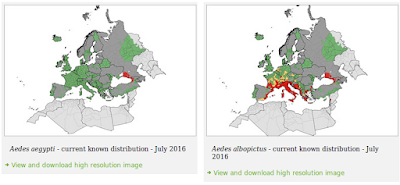#11,604
Although the explosive spread of Zika in the Americas has raised the level of concern, public health agencies in Europe have long warned that old arboviral threats - like Malaria, Dengue, and Yellow Fever - could one day return to parts of Europe.
In 2007 Italy got a surprise wake-up call when the Chikungunya virus arrived (via a traveler returning from India) in the northern province of Ravenna, eventually infecting nearly 300 people.
While the Chikungunya virus isn't normally found in Europe, the vector, the Aedes mosquito, is (see It's A Smaller World After All). All it took was for one infected person to arrive and provide a blood meal to the right kind of mosquito to spark a local epidemic.
Since then, we’ve seen a procession of studies suggesting that Europe is increasingly becoming a suitable environment for many vector borne diseases. In 2010 the ECDC's journal Eurosurveillance devoted a special edition to exactly that threat in Vector-borne diseases - December 2010.
The following year, in ECDC: Local Malaria Acquisition In Greece, we saw even more reasons for concern with the return of a scourge that had – due to diligent mosquito control measures over the past 50 years – been all but eliminated across Europe.
In 2012 the ECDC released a cautionary report on the Status & Importance Of Invasive Mosquito Breeds In Europe followed in 2014 when they announced a new joint ECDC-EFSA project called “VectorNet” (see ECDC Vector Maps: Invasive Ticks, Mosquitoes & Sand Flies).
Today the ECDC has released updated maps showing the known distribution of five types of Aedes mosquitoes, with particular emphasis on the Aedes aegypti and Aedes albopictus which can transmit Zika, Dengue and Yellow Fever.
Mosquito maps: New information about areas with Aedes albopictus and Aedes aegypti in Europe
03 Aug 2016
The latest ECDC mosquito maps show new information about the geographical distribution of Aedes albopictus and Aedes aegypti, invasive mosquitoes which can transmit diseases such as dengue and Zika, in Europe. (See mosquito infographic)
Specifically, the maps include new reports about the presence of the two mosquito species in several areas:
- Aedes albopictus - updates are available for the following countries: Austria, Bosnia and Herzegovina, France, Georgia, Germany, Greece, Italy and Turkey
- There are reports about Aedes aegypti in Turkey
The new mosquito maps show the current known distribution of the invasive mosquitoes in Europe at ‘regional’ administrative level as of July 2016. The maps are also presented in new, improved layout.
The data is collected by vector-borne disease experts, through VectorNet, a joint initiative of the European Food Safety Agency (EFSA) and the European Centre for Disease Prevention and Control (ECDC). The project supports the collection of data on vectors related to both animal and human health. The information on the mosquito presence is gathered by external experts of mosquitoes and mosquito-borne diseases and validated by designated experts from ECDC and EFSA. However, the data do not represent the official view or position of the countries.
See the ECDC mosquito maps.
